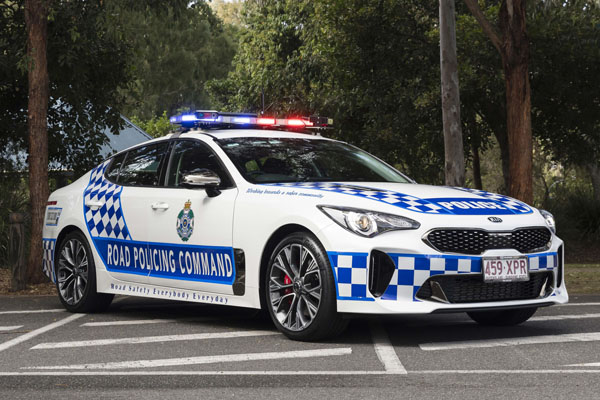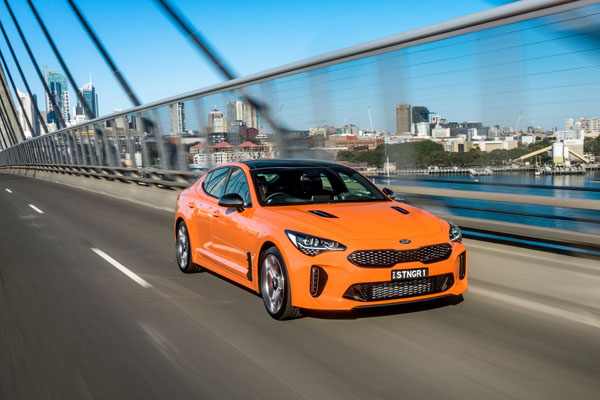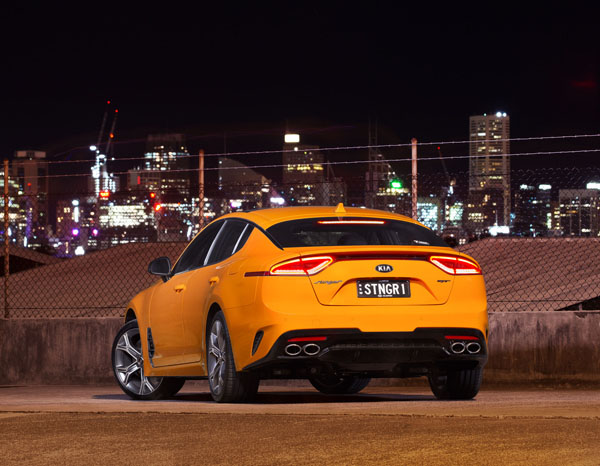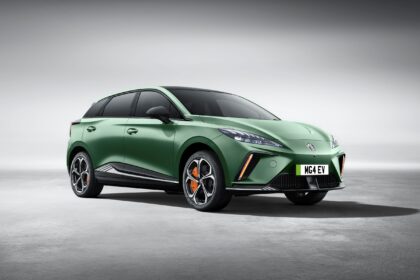
The Stinger continues to earn its stripes in the pursuit of the forces of evil as a car of choice for police, with the Northern Territory the latest recruit for Kia’s sports sedan with the ability to run down lawbreakers.
Queensland police began the ball rolling, becoming the first law enforcement agency in the world to use the Stinger as an operational intercept and road command vehicle, nudging out the traditional now-extinct Holden Commodore and Ford Falcon.
Western Australia followed suit, with NT recently jumping on the bandwagon, taking on the rear-wheel-drive liftback models powered by a 3.3-litre twin-turbo V6 petrol engine developing 272 kW of power and 510 Nm of torque.
That has the vehicle sprinting from a standstill to 100 km/h in just 4.9 seconds, enough to collar most crooks.
There is a Stinger 2.0 200S four-cylinder automatic, which comes to market at $47,190, followed by the 2-litre GT-Line automatic, $56,290; Stinger 3.3 V6 330S automatic, $50,190 (the test vehicle) and 3.3 V6 GT automatic, $60,790.
STYLING
It’s no coincidence the Stinger sings straight from the European sports sedan songbook, as Kia design chief Peter Schreyer made his name with German automaker Audi.
Designers toned down any brutal characteristics, combining elegance with an athletic look, which together with rear drive, delivers a roomy passenger cabin and spacious boot, the latter to take bulky luggage or a couple of golf bags.
Not that everything is soft and gentle. There’s still the Kia signature ‘tiger-nose’ grille, bold LED headlamps, two twin oval exhaust pipes. A flat underbody and rear diffuser enhance aerodynamics.
INTERIOR
A long wheelbase (2905 mm) and fastback rather than sedan-style rear leave plenty of front and rear leg room for passengers, plus a driving position fit for spirited action.
Contoured seats are available with leather-look trim, while the driver can take advantage of an optional four-way air-cell lumbar support and side bolsters for increased comfort.
INFOTAINMENT
Latest technology includes a head-up display, with speed, turn-by-turn navigation guidance, audio, cruise control and blind-spot detection information.
All Stingers boast Bluetooth connectivity through Apple CarPlay and Android Auto, while smartphones can be charged via a pad in the centre console. Built-in satellite navigation comes with ten years of updates. Six speakers deliver crisp audio controlled through an 8-inch screen.
ENGINES / TRANSMISSIONS
The Stinger is available with a choice of two petrol engines – a single turbo 2.0-litre four-cylinder producing 182 kW and 353 Nm, or a twin-turbo 3.3-litre V6, which stumps up 272 kW and 510 Nm.
Mated with Kia’s own eight-speed automatic transmission driving the rear wheels via a mechanical limited-slip differential, the latter gives the car its high-performance pedigree with a claimed sprint from zero to 100 km/h in 4.9 seconds, using launch control, and a top speed of 270 km/h.
SAFETY
Advanced driver assistance technology includes autonomous emergency braking with forward collision warning system, front parking sensors, a lane keeping assist and driver attention alert.
Standard safety equipment includes stability control and seven airbags. There are airbags directly in front of the driver and front passenger; two outside the driver and front passenger to protect their upper bodies from side impacts; a knee airbag to protect the driver’s knees and curtain airbags that protect the heads of front and rear occupants from side impacts. A reversing camera is also standard.
DRIVING
With its 3.3-litre V6 there’s the promise of a fun drive – with sting, swift acceleration and more engaging. However, the V6’s muted engine and exhaust note when the test foot was flattened was something of a disappointment. An optional sports exhaust might be the go here.
With official combined urban / highway fuel consumption of 10.2 litres per 100 kilometres, the test car came up with an on-target 13.5 in town and an impressively low 5.3 litres on motorways.
All Stingers have an eight-speed automatic transmission transferring power to the rear wheels. Sadly, it often switches to a higher gear too soon. Using the steering wheel-mounted paddles brings shifts to a more satisfying, slicker response. Brembo brakes are up to the task of reining in the ample ‘horses’.
Auto-levelling and dipping headlights switched between searchlight main beam and candlepower illumination seemingly at random, regardless of the visibility ahead.
A steeply-sloped rear window presents a limited view for the driver and misses out on a rear wiper, which just about wipes out a clear view behind in wet weather.
Taller passengers must bend double to slot under the low, coupe-style swoopy roofline to get into the rear seats. The boot is generous with depth but not so with height.
SUMMING UP
With its police presence, the fact that the Stinger is out there nickin’ villains adds a certain cachet to the sports sedan. Kia’s seven-year warranty means the owner is in for a decent stretch too.
AT A GLANCE
MODEL LINE-UP
Kia Stinger 2.0 200S automatic $47,190
Kia Stinger 2.0 GT-Line automatic $56,290
Kia Stinger 3.3 V6 330S automatic $50,190
Kia Stinger 3.3 V6 GT automatic $60,790
Note: These prices do not include dealer or government charges. Contact your local Kia dealer for drive-away prices.
SPECIFICATIONS
(Kia Stinger 330S 3.3-litre twin turbo V6 petrol engine, 8sp automatic)
Capacity: 3342 cc
Configuration: V6
Maximum Power: 272 kW @ 6000 rpm
Maximum Torque: 510 Nm @ 1300 and 4500 rpm
Fuel type: Petrol 91 RON
Combined Cycle (ADR 81/01): 10.2 litres per 100 km
CO2 emissions: 239 g/km
DRIVELINE:
Drivetrain: 8-speed automatic, mechanical LSD
DIMENSIONS, WEIGHT AND CAPACITIES:
Length: 4830 mm
Width: 1870 mm
Height: 1400 mm
Wheelbase: 2905 mm
Tare weight: 1780 kg
Turning circle: 11.2
Fuel Tank Capacity: 60 litres
BRAKES:
Front: Ventilated disc
Rear: Ventilated disc
WARRANTY:
Seven years / unlimited kilometres










